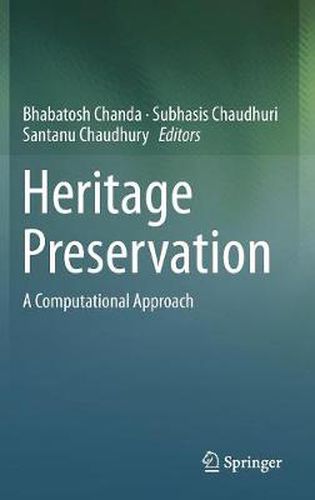Readings Newsletter
Become a Readings Member to make your shopping experience even easier.
Sign in or sign up for free!
You’re not far away from qualifying for FREE standard shipping within Australia
You’ve qualified for FREE standard shipping within Australia
The cart is loading…






This title is printed to order. This book may have been self-published. If so, we cannot guarantee the quality of the content. In the main most books will have gone through the editing process however some may not. We therefore suggest that you be aware of this before ordering this book. If in doubt check either the author or publisher’s details as we are unable to accept any returns unless they are faulty. Please contact us if you have any questions.
This book presents a unique guide to heritage preservation problems and the corresponding state-of-the-art digital techniques to achieve their plausible solutions. It covers various methods, ranging from data acquisition and digital imaging to computational methods for reconstructing the original (pre-damaged) appearance of heritage artefacts.The case studies presented here are mostly drawn from India’s tangible and non-tangible heritage, which is very rich and multi-dimensional. The contributing authors have been working in their respective fields for years and present their methods so lucidly that they can be easily reproduced and implemented by general practitioners of heritage curation. The preservation methods, reconstruction methods, and corresponding results are all illustrated with a wealth of colour figures and images.The book consists of sixteen chapters that are divided into five broad sections, namely (i) Digital System for Heritage Preservation, (ii) Signal and Image Processing, (iii) Audio and Video Processing, (iv) Image and Video Database, and (v) Architectural Modelling and Visualization. The first section presents various state-of-the-art tools and technologies for data acquisition including an interactive graphical user interface (GUI) annotation tool and a specialized imaging system for generating the realistic visual forms of the artefacts. Numerous useful methods and algorithms for processing vocal, visual and tactile signals related to heritage preservation are presented in the second and third sections. In turn, the fourth section provides two important image and video databases, catering to members of the computer vision community with an interest in the domain of digital heritage. Finally, examples of reconstructing ruined monuments on the basis of historic documents are presented in the fifth section. In essence, this book offers a pragmatic appraisal of the uses of digital technology in the various aspects of preservation of tangible and intangible heritages.
$9.00 standard shipping within Australia
FREE standard shipping within Australia for orders over $100.00
Express & International shipping calculated at checkout
This title is printed to order. This book may have been self-published. If so, we cannot guarantee the quality of the content. In the main most books will have gone through the editing process however some may not. We therefore suggest that you be aware of this before ordering this book. If in doubt check either the author or publisher’s details as we are unable to accept any returns unless they are faulty. Please contact us if you have any questions.
This book presents a unique guide to heritage preservation problems and the corresponding state-of-the-art digital techniques to achieve their plausible solutions. It covers various methods, ranging from data acquisition and digital imaging to computational methods for reconstructing the original (pre-damaged) appearance of heritage artefacts.The case studies presented here are mostly drawn from India’s tangible and non-tangible heritage, which is very rich and multi-dimensional. The contributing authors have been working in their respective fields for years and present their methods so lucidly that they can be easily reproduced and implemented by general practitioners of heritage curation. The preservation methods, reconstruction methods, and corresponding results are all illustrated with a wealth of colour figures and images.The book consists of sixteen chapters that are divided into five broad sections, namely (i) Digital System for Heritage Preservation, (ii) Signal and Image Processing, (iii) Audio and Video Processing, (iv) Image and Video Database, and (v) Architectural Modelling and Visualization. The first section presents various state-of-the-art tools and technologies for data acquisition including an interactive graphical user interface (GUI) annotation tool and a specialized imaging system for generating the realistic visual forms of the artefacts. Numerous useful methods and algorithms for processing vocal, visual and tactile signals related to heritage preservation are presented in the second and third sections. In turn, the fourth section provides two important image and video databases, catering to members of the computer vision community with an interest in the domain of digital heritage. Finally, examples of reconstructing ruined monuments on the basis of historic documents are presented in the fifth section. In essence, this book offers a pragmatic appraisal of the uses of digital technology in the various aspects of preservation of tangible and intangible heritages.